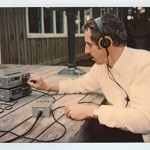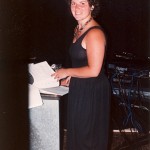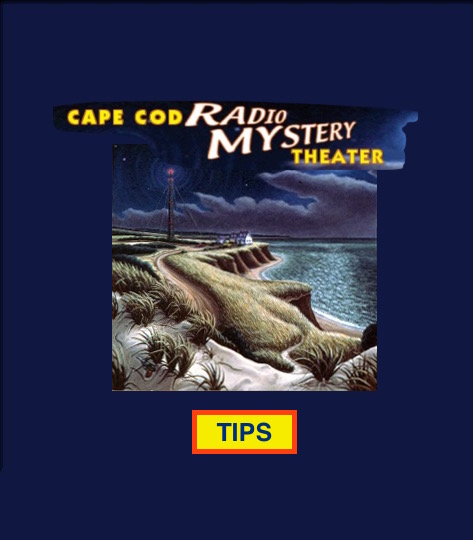Posted in Liner Notes, What's New
‘REVENGE OF THE TITANIC’ and ‘MR. HUGO’S NIGHT TO REMEMBER’
NOTES ON THE PROGRAMS:
‘REVENGE OF THE TITANIC’
AND
‘MR. HUGO’S NIGHT TO REMEMBER’
Recorded at: ‘Revenge of the Titanic’ recorded at
HT Recording Studio, Cape Cod and at
Producers I and II, Hollywood, Los Angeles
Live performance: ‘Mr. Hugo’s Night to Remember’ live performances recorded at the
Woods Hole Community Hall, July 14th and 15th 1989
First broadcast: ?
Cast of ‘Revenge of the Titanic’: (unpublished)
Dug Credit, Allen Nelson, Michael Mellor .
Judith Provost, Jim Grandlund,
Stephen Russell
Cast of “Mr. Hugo’s Night to Remember’:
Announcer . . . . . . . . . George McConville
Hugo LeGrande ‘The Great Hugo’ . . . Dug Credit (*)
Mr. Smalley, Sailor #1 and Ted Bicknell, Anchorman . . . Stephen Russell
‘Robin Leach’ and Newsreel Announcer . . . Michael Mellor (*)
Dame Eva Hartley . . . Carol McManus
Ship Captain . . . . . . . . . Allen Nelson (*)
Sailor #2 and Craig . . . . . Jim Granlund (*)
Man . . . . . John Cullity (*)
Sound effects:
John and Lynn Cullity, Rich Gady, Tony Baker, Debby Oney
Recording enginner: Dave Goodman
(*) First appearance in a CCRMT program
Author’s Notes and Recollections:
The play was conceived not long after the Robert-Ballard-led expedition that thrillingly discovered the Titanic wreckage and then heroically resisted the temptation to help themselves to its souvenirs. In the play’s first incarnation it was titled ‘Revenge of the Titanic’ and it was recorded at John Todd’s garage recording studio in Dennis. Our ‘bathysphere’ was a fiberglass, module Tupperware couch that John’s wife, Jean, had won at a Tupperware convention.
We completed the dialogue and layered in the sound effects including some which John and I had gathered in a backyard, World War II battleship gun turret in Osterville. At this stage nobody was doing jumping jacks over how it was turning out, and when I took it out to Mark Birmingham in Los Angeles, it was clear he wasn’t too thrilled either. Even so he helped me finish it up, writing the music and sound designing some of the really big sound effects –like when the crew of the bathysphere hears their mother ship sinking on top of them, bulkheads bending with the pressure. A squeaky dumpster lid worked well for the raw sound, enhanced by digital processing. However, by the time I brought the show back to the Cape, I had come to the conclusion it just wasn’t working.
Its problems were structural as well as core.
Returning to the drawing board, I re-titled it “Mr. Hugo’s Night to Remember” (in echo of the 1955 non-fiction book ‘A Night to Remember’ by Walter Lord and the 1958 British film that followed).
One structural problem with ‘Revenge of the Titanic’ was that it didn’t set its moral position early enough and clearly enough to be understood. I added a new scene based on my conversation with Eva Hart, who at the time was the second oldest, living survivor of the disaster –she was seven when it happened– and whom I met at a Titanic Historical Society convention in Boston. In the new scene Dame Hartley is interviewed just prior to Hugo and Mr. Smalley descending to the wreck. The scene stakes out the moral position more clearly and also allows for some foreshadowing of the fatal consequences that might befall anyone trespassing on a grave-site (think: King Tut’s Tomb and a thousand other grave-tampering mysteries).
The core problem with the play, however, was more difficult to fix. The problem is that it attempts to excoriate and lampoon a character trait that almost all of us share. After all, who among us wouldn’t want to own a piece from the Titanic? (Just as I am glad to own a handwritten letter I received from Mrs. Hart following our production which I hold onto as a treasured keepsake.)
Nevertheless, just because we all share the same covetous desire to own bits of history doesn’t mean we ought not to lampoon the impulse, especially in its most virulent form, and Dug Credit, who played ‘The Great Hugo’ in both productions, demonstrated how well he could create the perfect buffoon for the part.
Once the script changes were done, we decided we couldn’t afford another lengthy studio recording, so instead, in a more cut and run approach, we decided to stage a couple of live performances and record each one in the hopes that one would be good enough to issue as a recording.
The obvious location to perform it was Woods Hole. During development of ‘Revenge of the Titanic’ I had technical assistance from Martin Bowen, pilot of the Alvin submarine, as well as from the Benthos Company, makers of underwater microphones and other sophisticated underwater gear. The Woods Hole Oceanographic Institute was willing to allow us use of the Woods Hole Community Hall which is located alongside the drawbridge and canal connecting Eel Pond to the Nantucket Sound.
I still think it was a strong cast and several actors stand out in my memory: Dug as the perfect Hugo, Stephen doing his Milquetoast, the legendary George McConville putting in an appearance as the Announcer. Carol McManus striking a noble pose as Dame Hartley. Newcomer and free-floating genius-type Michael Mellor did a great job perfectly mimicking Robin Leach and the Newsreel Announcer, although during one performance he forgot to show up on cue when the newsreel projector sound started up (we had to cut his lines in later). Michael deserves extra credit and honorable mention, however, for the fun comic book-style poster he supplied as well as his excellent line drawing of the cast. (Clockwise from left: George McConville, Steven Oney, Michael Mellor, Carol McManus, Debby Oney, Dug Credit and Stephen Russell)
The stage sound effects were handled by John Cullity and his wife, Lynn, manning the snorkels and aquarium bubblers. Debby operated the battery powered cigarette ashtray that had a little fan which sounded like an air scrubber and she also contributed eerie musical sounds playing a set of her long-stemmed, crystal wedding goblets, rubbing their rims with moist fingers to set up the ghostly, hollow-ringing sound that so enhanced the spooky underwater atmospherics. Tony Baker ran the pre-recorded sound effects from the upper gallery. And fellow carpenter and friend, Rich Gady, was somehow conned into joining our sound effect orchestra, performing on wading pool-and-washtub. (We used a ten-foot, circular wading pool and filled it with gallons and gallons of water. For safety sake, we used two pools, one inside the other, and then discovered just after the second performance that one of the vinyl linings had split and the remaining one wasn’t looking all that dependable. With hasty dispatch we quickly employed a garden hose to siphoned the water out the window and into the adjoining alley, quick action that may have prevented a Noah-sized flood from inundating the hardwood floors.)
Another memory concerning the sound effects had to do with the Hall being located right on the canal and right beside the drawbridge. We worried about a sailboat coming up and using its air-horn to signal the bridge operator to raise the drawbridge. Air horns and drawbridges make marvelous sound effects, but not when your audience is supposed to be inside a quiet bathysphere two and a half miles underwater. We begged the bridge man not to let the bridge go up or horns to sound during the recording. I think we even offered him a bribe. Although shunning the proffered inducement, he promised for an hour the bridge would not go up and no horns would sound and he kept his word.
The temperatures inside the room were sweltering hot during both performances and stuffy too because all the windows had to remain closed, but the audiences didn’t seem to mind. They were appreciative and seemed to enjoy it and we came away with the feeling we had finally come up with a recording we could live with.
How does the author feel now about the play more than 20 years later? I note that in the coming month of April an auction is to take place that will sell off in one lot all of the currently salvaged Titanic items to the highest bidder. The estimated sale price is180 million dollars.
I guess I still feel the way I originally did, siding with Eva Hart and Captain Ballard that the grave-site ought not to be disturbed and that leaving it alone was the best way to preserve its mystery, but I have also softened a bit. My feeling now might be akin to the way I feel about animals in the wild versus animals in zoos. I would rather see them in their pristine state but if they are driven to extinction out of the wild then I am glad there are zoos that can take them in. I hope the artifacts will be kept together and end up in a museum that takes its job seriously and its obligation to preserve the past and help re-tell to future generations all about this historic event, with its many lessons, heroics and metaphors. I’ll be glad if a grand exhibit becomes a reality, –I might even come see it–but I also wouldn’t mind if, like in our radio play, the exhibit also included an hermetically sealed bathysphere containing the perfectly preserved remains of The Great Hugo and his hapless pilot, Mr. Smalley.
Steven Thomas Oney


















Was this your most challenging drama? If not, which one would you say?
Hi Quinn!
Nice of you to contact us again.
Steven says this was indeed a challenging mystery to write, requiring many re-writes and time.
All the shows are challenging to him, but Hugo was the most difficult “delivery.”
The Final Case also was difficult, not only for its melancholy subject but for the kind of peculiar mystery it was. He had some crucial help from Mark editing that one.
By the way, he also says that in terms of challenge the one he is working on now makes the others look like child’s play.
Thank Annie!
That last paragraph sounds awfully tempting…